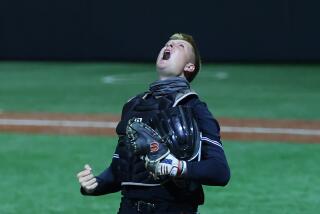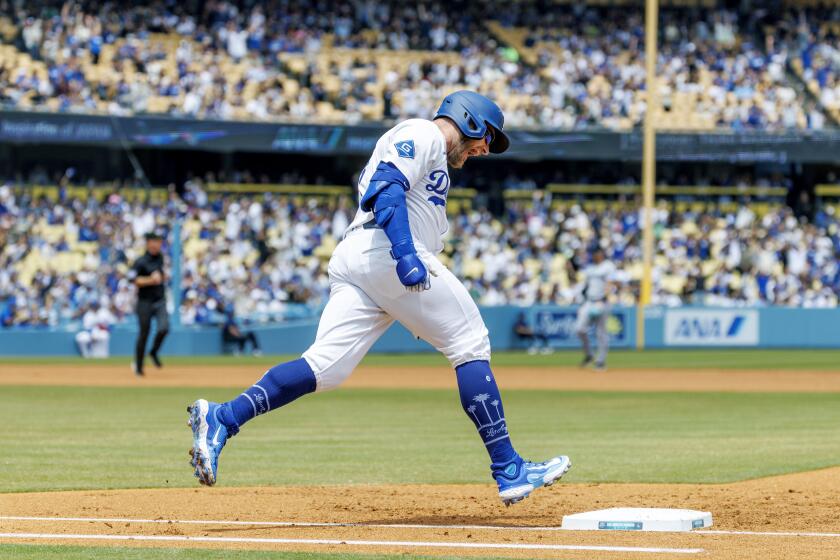Wellspring of Talent
- Share via
Oh, if all harvests were like this.
In what some have called the deepest local recruiting class in memory, six former Southland prep players were taken in the recent NBA draft.
“It was definitely a strong showing,” UCLA Coach Steve Lavin said. “It’s indicative [of] the talent that’s coming out of Southern California. That’s one reason schools like Duke, Kansas and Arizona are out here recruiting--because the best players are out here.”
Bob Gibbons of All-Star Sports, which scouts and makes recruiting reports for more than 300 colleges, agrees.
“The best overall [national] class I remember since I have been doing this is 1979, which had guys like Isiah Thomas, James Worthy and Ralph Sampson, to name a few,” Gibbons said. “But this is maybe the deepest class from the Southland that I can remember.”
Interestingly, three of the picks from the Southland were not rated very high on recruiters’ lists: Keith Van Horn, Austin Croshere and James Cotton.
Pepperdine Coach Lorenzo Romar, an assistant coach at UCLA four years ago and the key figure in the recruitment of members of the Bruins’ 1995 national championship team, personally scouted and recruited many among the class of 1993, including Charles O’Bannon of Lakewood Artesia High and Jacque Vaughn of Pasadena Muir.
Vaughn, who attended Kansas, was drafted 27th overall by the Utah Jazz, and O’Bannon was the third pick of the second round, by the Detroit Pistons.
Romar, who ultimately landed O’Bannon for UCLA, said one could tell even then that O’Bannon and Vaughn someday would be professionals, based on athleticism and work habits.
Although Romar did not personally recruit Ed Gray, then of Riverside North, another recruiter Romar respected saw Gray play only once and told Romar: “That guy is going to be a pro.”
In this case, the scout was right. Gray, the Pacific 10 Conference player of the year at California, was taken in the first round by the Atlanta Hawks.
“Most of the time you can just tell,” said Mitch Kupchak, Laker general manager. “The way a player handles the ball, the way he warms up--you can see the maturity by the way they walk, the way they warm up. Within a half-hour you know. With Kobe [Bryant, who was drafted out of high school] we knew he had what it took athletically and physically.”
But Kupchak cautioned that an assessment like that comes in a private workout; scouting high school players at games is much more problematic. When Kupchak went to a high school tournament last year, it was his first time scouting that level.
“I was very uncomfortable,” Kupchak said. “The kids knew we were there and they start playing for us instead of playing for their school and trying to win the game.
“Also, with high school games, you have no frame of reference. You’re watching them play against their peers, none of which is ready to go to the NBA. I mean, some kids are 15. Tracy McGrady, I saw, and you knew that there was something there. But at that point you would have to bring him in for a workout.”
So even when talent is evident, scouts need to see more.
“There are many in ability alone that are ‘can’t miss,’ ” said Romar, who said he first observed pro scouts in the stands about two years ago.
“It’s not hard to look at talent. The potential is easy: That guy is the best on the floor. But the intangibles are just as important: How hard will he work? So you talk to people. Does he play hard against big-time competition and not small competition? How much time does he spend away from the gym? Things like that.”
Given their hard work and considerable talent, O’Bannon, Vaughn and Gray seemed to be sure things, but who knew about Van Horn, Croshere and Cotton?
While they were often the best players on the court in high school, there were concerns among scouts and recruiters if their games would translate to the next level.
“A couple of people told me ‘There’s a skinny kid at Diamond Bar you gotta go see,’ ” Romar said, referring to Van Horn. “I saw him and realized he had a great touch and great skills. But his freshman year at Utah I didn’t see him as being the No. 2 pick in the NBA draft. But as a sophomore you could see he had a chance.”
He has more than a chance, it turns out. Van Horn was the No. 2 pick overall by the Philadelphia 76ers, who traded his rights to the New Jersey Nets.
Croshere, who went to Providence from Santa Monica Crossroads High, represents what Gibbons called a “quantum leap.”
All-Star Sports rated the top 750 players in the nation for 1993 and Croshere was No. 194.
But with a nice outside shot, a good step to the basket, and a burning desire to work, Croshere blossomed at Providence.
“Sometimes you have late bloomers,” Lavin said. “If a kid doesn’t develop until his senior year, at that point you may have used up all your scholarships. Or maybe you already have people at the same position so you don’t have a need. There are a lot of variables.”
Croshere grew into the 12th pick of the draft, selected by the Indiana Pacers.
For Cotton, it wasn’t a matter of developing late at St. John Bosco High, it was whether his 6-4 frame was commensurate with his future position. Cotton was a frontcourt player in high school and would have to be a guard in college.
His talent and work ethic were not questioned as much as whether he would make a successful transition to the perimeter game in college, and some programs stepped back because of that.
“Never underestimate hard work,” Romar said. “Cotton was a [6-4] center in high school, but you couldn’t find anyone to outwork him--you couldn’t find anyone with more desire.
“He is the kind of guy who would work out six or seven hours a day and feel guilty about not working the eighth. You see guys like that and those are the guys you want.”
However, Romar did not recruit Cotton heavily, primarily because Cotton would have to make the transition while UCLA needed impact freshmen, the kind they expected Charles O’Bannon to be. UCLA did not have an extra scholarship to develop a player, and Cotton ended up going to Long Beach State.
Said Gibbons: “He probably benefited by going to Long Beach State. He was a terrific athlete, so by going to a lower-level [program], he could work on his perimeter game.
“That’s not to downgrade Long Beach State. If he had been trying to dunk over 6-10 guys in the Pacific 10 [Conference], he might not have developed as well.”
Perhaps the most unfulfilled expectations of the recruiting class of 1993 was O’Bannon’s teammate at Artesia, Avondre Jones.
At nearly 6-10, Jones had the height scouts wanted and was stronger than Van Horn. He played well with O’Bannon and the two helped their team win a state title as seniors.
“I thought that if Avondre worked hard, he had the potential to be a professional,” Romar said.
However, Jones clashed with then-USC coach George Raveling over playing time as a freshman. When Raveling left, so did Jones, shopping his services at the Olympic Festival in St. Louis. He didn’t do too well at there and ended up playing a year at Chaffey Community College. He transferred back to USC for his junior year but again left because of a lack of playing time. He transferred to Fresno State and is eligible to play for Jerry Tarkanian this season.
“Today, the supposed ‘can’t-miss’ kids don’t reach their potential,” Romar said. “Too much is given to them. If someone does try to discipline them, they say, ‘I’m transferring.’ ”
Romar, who will have a few big-name transfers on his team this season--including former Cal player Jelani Gardner and former Bruin omm’A Givens--said the best-known high school players will pan out if they are scouted well enough for their work ethic, class work, citizenship and are going into a system where their talents fit.
With so many variables to consider, that is a luxury afforded only the top programs. Other schools often have to take much greater risks with their scholarships.
“With the risk [recruits], you know the risks. But there are a lot of kids in the pros who weren’t known at all in high school,” Romar said.
“Look at the NBA finals. Scottie Pippen was a manager for the basketball team his freshman year of college. There’s not a large percentage of ‘can’t-miss’ high school kids who make it to the pros.”
(BEGIN TEXT OF INFOBOX / INFOGRAPHIC)
They Were Kings of the Court
Top 30 of the Southland’s 1993 recruiting class in alphabetical order: *--*
Name High School Position College 1. Matt Ambrose Huntington Beach forward Portland State 2. Stais Boseman Inglewood Morningside guard USC 3. Michael Boyd Gardena Serra forward CS Sacramento 4. James Cotton-a St. John Bosco guard Long Beach State 5. Austin Croshere-b Santa Monica Crossroads forward Providence 6. Jeff Cummins La Palma Kennedy forward Westmont 7. Michael Dean Torrance guard Azusa Pacific 8. David Drakeford Santa Ana Mater Dei guard Oregon State 9. Dominic Ellison Inglewood Morningside guard Washington State/ New Mexico State 10. Jim Faulkner Costa Mesa Estancia guard Southern Utah State 11. Nick Foster Thousand Oaks forward Pacific. 12. Paul Foster Thousand Oaks forward UC Irvine 13. Ed Gray-c Riverside J.W. North guard Tennessee/Cal 14. Jimmy Harris Huntington Beach Ocean View guard Loyola Marymount 15. Bryan Hill Wilmington Banning forward Pepperdine 16. Akeli Jackson Gardena Serra center CS Long Beach /Cal Poly Pomona 17. Avondre Jones Lakewood Artesia center USC (twice)/ Chaffey/Fresno State 18. Kyle McIntosh South Torrance center Georgetown, didn’t play. 19. Richard Mandeville La Canada forward Indiana 20. Monte Marcaccini SO Notre Dame guard Indiana/ Pepperdine/Virginia 21. Charles O’Bannon-d Lakewood Artesia forward UCLA 22. Michael O’Quinn Pasadena Muir center Loyola Marymount /CS Northridge 23. Chris St. Clair La Habra Sonora guard CS Fullerton 24. Corey Saffold Inglewood Morningside center Oklahoma/ LB State/CS Dominguez Hills 25. David Sedgwick Mission Viejo Capistrano Valley guard Brigham Young 26. Arthur Tate Gardena Serra forward CS Sacramento 27. Jacque Vaughn-e Pasadena Muir guard Kansas 28. Keith Van Horn-f Diamond Bar center Utah 29. Marmet Williams Santa Ana a Mater Dei forward San Jose State 30. Jimmy Williamson South Torrance guard Loyola Marymount
*--*
a-drafted by Denver Nuggets (No. 33), rights traded to Seattle SuperSonics; b-drafted by the Indiana Pacers (No. 12); c-drafted by Atlanta Hawks (No. 22); d-drafted by Detroit Pistons (No. 32); e-drafted by the Utah Jazz (No.27); f-drafted by Philadelphia 76ers (No.2). Rights traded to New Jersey Nets.
More to Read
Go beyond the scoreboard
Get the latest on L.A.'s teams in the daily Sports Report newsletter.
You may occasionally receive promotional content from the Los Angeles Times.










